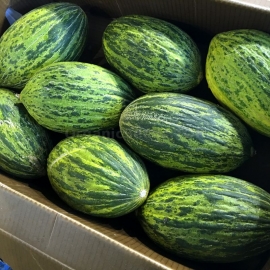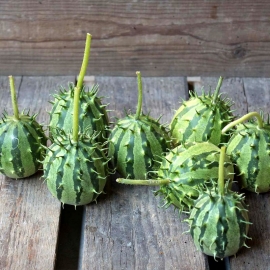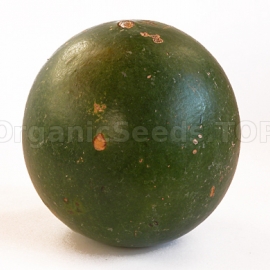









«Piel de Sapo» - Organic Melon Seeds
1.14 €
The name translates as 'Toad Skin' and the skin of this Spanish-style melon does indeed resemble this amphibian with its mottled green skin with flecks of yellow and wrinkles when ripe.
-
Heirloom melon «Piel de Sapo»
The name translates as 'Toad Skin' and the skin of this Spanish-style melon does indeed resemble this amphibian with its mottled green skin with flecks of yellow and wrinkles when ripe.
However, the reason vast areas of La Mancha are dedicated to growing this variety is its incredible sweet taste which many people think resembles a water melon. The white flesh itself is similar to a honeydew with just a hint of gold around the seed cavity.
How to grow
Sow
Sow two seeds 1.5cm (1/2in) deep from mid- to late April, in a propagator or on a sunny windowsill at 18-21ºC (64-70ºF). Remove the strongest seedling after germination. Harden off (acclimatise to outdoor conditions) from late May to early June, once there is no danger of frost, and when they have three or four leaves.
Grow
Melons are tender plants, so need a warm, sunny spot with high humidity. In the UK it is best to grow in a glasshouse, polytunnel or under a cloche or in a coldframe. Melons need a rich, fertile, moisture retentive, deep and well-drained soil. Three to four weeks before planting, prepare the ground by removing weeds and incorporating up to two bucketfuls of organic matter and a modest dressing of general purpose fertiliser. Water well and cover in clear polythene for a week before planting to warm the soil.
Pinch out the growing point at the fifth leaf to encourage side shoots, when they appear, retain the four strongest and remove the others. In a coldframe, train the four shoots into an X shape. Under cloches, train one pair each way. In very sunny weather, shade indoor crops with netting or whitewash on the glass. Keep well watered at all times. When fruit are the size of walnuts, feed with a high potash potassium liquid fertiliser every 7-10 days. Stop feeding and reduce watering when the fruits start to ripen and foliage dies back.
Increase ventilation and remove shading once plants become established, but remember to re-apply shading later in summer if temperatures exceed 25ºC.
Harvesting
Harvest when they produce the characteristic melon fragrance and the fruits start to crack near the stem.
Products Viewed Before
Product code: 11660
3.00 €
This horned cucumber plant is a annual vine, 1.5 to 3m long of African origin. The stem is angular, ridged and hairy; internodes are 5-8cm long. At each node, a 2.5 to 5cm long curling tendril forms, along with two to four pale yellow male flowers.
Product code: 3374
2.10 €
3.00 € (Sale: 30%)
Though many of the plants in the Hibiscus genus grow in tropical or semitropical regions, several hardier species such as this one are native to North America. Experimental gardener Thomas Jefferson included this species of hibiscus in his list.
Product code: 11102
1.14 €
Celosia (Celosia Plumosa Nana Glitters Mix) - What an exotic annual that is easily and quickly grown from Celosia seeds! Called Woolflower, Plume Plants or Feathered Amaranth, these mix, silky blooms get attention!
Product code: 11330
1.14 €
Round and pretty dark green fruits With a diameter of about 12 cm (5 in) and the appearance of its namesake, Cannon Ball can be dried to use it for crafting, painting and decorating.




